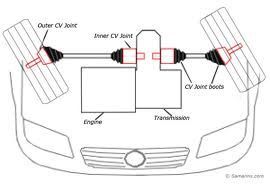
CV boots CV Joints (Constant velocity joints)
All front-wheel drive cars have Constant Velocity joints or CV joints on both ends of the drive shafts (half shafts).
Inner CV joints connect the drive shafts to the transmission, while the outer CV joints connect the drive shafts to the drive wheels. Many rear- and four-wheel drive cars and trucks also have CV joints.
The CV joints are needed to transfer the torque from the transmission to the drive wheels at a constant speed, while accommodating the up-and-down motion of the suspension. In front-wheel drive cars, the CV joints also have to be able to deliver the torque to the front wheels during turns.
There are two most commonly used types of CV joints: a ball-type and a tripod-type. Ball-type CV joints are commonly used on the outer side of the drive shafts, while the tripod-type CV joints mostly used on the inner side of the drive shafts in front-wheel drive cars.
A CV joint is packed with a grease and sealed tight by the rubber or plastic boot. A CV joint doesn't need any maintenance and can last very long, as long as the protective CV joint boot is not damaged.
A most common problem with the CV joints is when the protective boot gets damaged. Once this happens, the grease comes out and the moisture and dirt come in, causing the CV joint to wear faster and eventually fail due to lack of lubrication and corrosion. Usually the outer CV joint boot breaks first, as it has to endure more movement than the inner one.
One of the early signs of a broken CV joint boot is a dark grease splattered on the inner side of the rims and around the inside of a drive wheel; around the area where the CV joint is located. If you take your car for a maintenance to a repair shop regularly, your mechanic can spot the problem early and let you know. Sometimes you can see the cracks and signs of wear on the boots before they break.
If a damaged CV joint boot caught early, simply replacing the boot and repacking the CV joint with a fresh grease is all that is usually needed to fix the problem. If the car is continued to be driven with a damaged CV joint boot, the CV joint will eventually fail. A most common symptom of a badly-worn CV joint is a clicking or popping noise when turning. Usually the noise gets louder when accelerating in turns.
In worst cases, a badly-worn CV joint can even disintegrate while driving causing the vehicle to stop; I've seen this happening few times.
A damaged CV joint is not repairable. It will have to be replaced with a new one. The CV-joint boot replacement could range from 120 to $400, even though the rubber boot itself usually costs around $30-$70. This is because of the large amount of labour involved.
